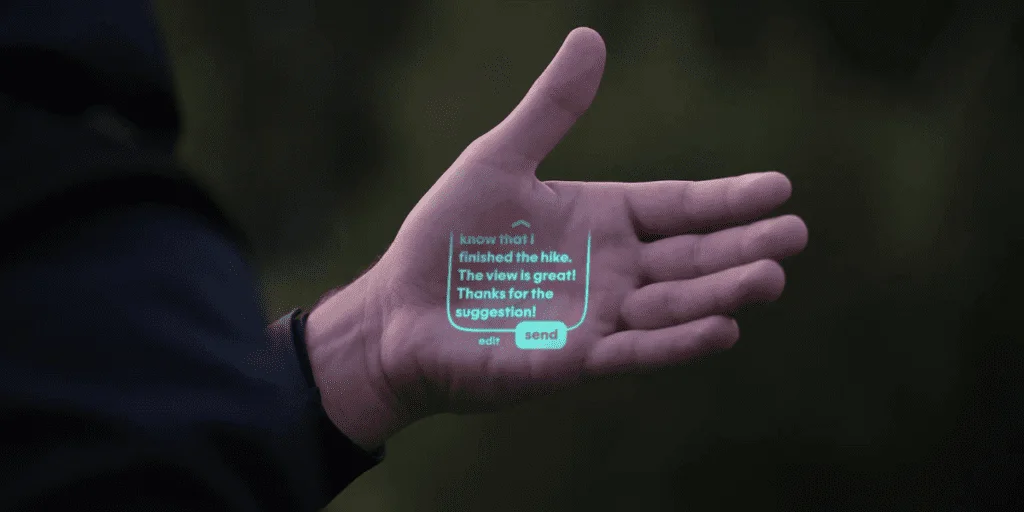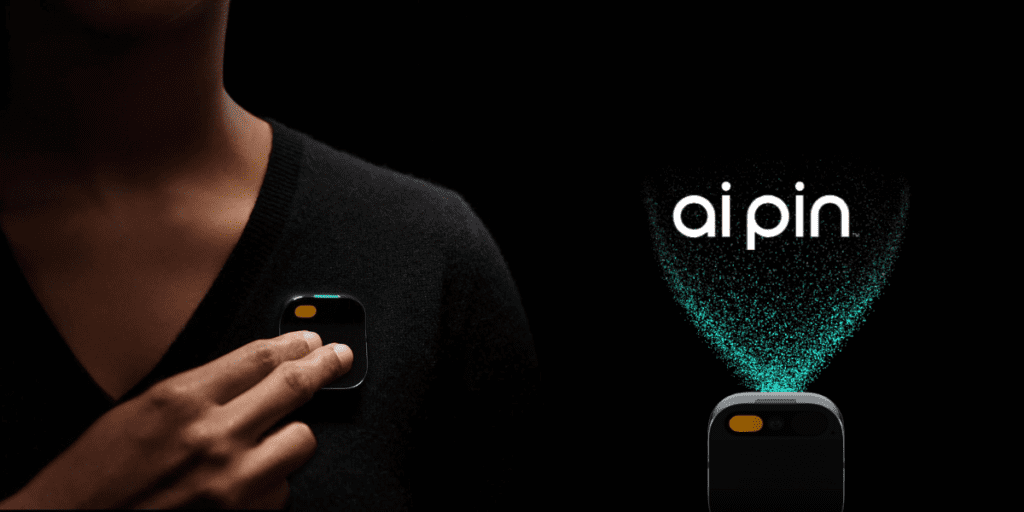Launch of Humane’s AI Pin marks a significant leap towards a future that many still consider to be in the realm of science fiction.
The Humane’s Ai Pin introduces a novel concept that is a bold departure from conventional smartphones. This wearable device projects an interactive screen directly onto the user’s palm.
This innovative gadget, which became widely available in the United States in April 2024, combines advanced artificial intelligence with practical functionality. It aims to streamline communication in an unobtrusive manner.
Retailing between $699 and $799 with an additional monthly service fee, the Ai Pin is not just a gadget but a potential harbinger of a screenless future.
Powered by technology developed by OpenAI and backed by Microsoft’s cloud computing might, this device promises to deliver a seamless, hands-free digital experience.
From making calls and sending texts to managing emails and fetching online information—all through voice commands and simple hand gestures—the Ai Pin positions itself as the ultimate personal assistant.
As we delve deeper into its capabilities and implications, let’s explore how this device could change the fabric of mobile communication and personal technology.
Humane Ai Pin
Humane’s Ai Pin reimagines the way we interact with our digital environments. The device is compact and discreet, designed to clip magnetically to any piece of clothing, offering unparalleled convenience and mobility.
This design not only ensures that the Ai Pin is always accessible but also maintains a minimalistic aesthetic that appeals to modern tech consumers.
The cornerstone of the Ai Pin’s technology is its Laser Ink projection system. Instead of a traditional screen, the device projects a high-definition display onto the palm of the user’s hand. This interactive projection allows users to control the interface through a series of intuitive hand gestures.

The AI Pin is equipped with a voice-activated AI assistant. It operates much like enhanced versions of Siri or Alexa but with quicker response times and more accurate interactions due to its advanced AI algorithms powered by OpenAI technology.
- Users can make calls and send texts entirely hands-free. This feature is handy for those needing to stay connected while moving.
- The device can take notes, set reminders, and answer complex questions by searching the internet, much like a conventional smartphone, but without physically interacting with a screen.
- Multimedia Management: Users can command the Ai Pin to play music, take pictures, or record videos, all of which are stored securely in cloud-based services provided by Microsoft.
- The device can offer real-time directions and translations, making it an invaluable tool for travellers.
- For those with visual impairments, the Ai Pin’s audio-centric nature and gesture-based controls can offer a new way to interact with technology without reliance on a visual display.
- The Ai Pin can deliver presentations, perform on-the-spot research, or manage schedules without using more cumbersome devices in professional settings.
Market Position and Pricing
Humane’s Ai Pin enters the market with a robust pricing strategy tailored to differentiate it from traditional smartphones and wearable technology.
The Humane Ai is available in two price tiers: $699 and $799, the difference often reflecting colour variations or additional premium features.
This initial cost is augmented by a required monthly service plan costing $24, facilitated through a partnership with T-Mobile’s 4G network. The service plan includes unlimited talk, text, data, and a dedicated phone number, crucial for the device’s full functionality.
The Ai Pin is positioned as a premium product, not just in terms of price but also in the sophistication of its technology and the unique user experience.
By leveraging cutting-edge AI and projection technology, the Ai Pin appeals to tech enthusiasts looking for the latest innovations, professionals who benefit from a hands-free device, and those interested in leading a more digitally integrated lifestyle without the constraints of a physical screen.
The pricing and features of the Ai Pin suggest it is targeting a mid to high-end market segment. This includes consumers who are early adopters of technology, value innovation and are willing to invest in premium products that offer enhanced convenience and functionality.
The device appeals to business professionals who need a seamless way to stay connected and manage tasks without being tethered to multiple devices.
The Humane Ai Pin is also positioned as an accessible device with potential benefits for users with disabilities. Its voice-activated interface and hand projection system could offer a more accessible technology solution for those who find traditional screens challenging.

In a market saturated with smart devices, the Ai Pin stands out by creating a new wearable, screenless technology category.
Unlike smartwatches or fitness trackers that complement smartphones, the Ai Pin aims to replace them with many functions, providing a more discreet and integrated user experience.
This positions Humane’s product not just as another gadget but as a potential trendsetter in the evolution of personal technology.
Consumer Reception and Reviews
Humane’s Ai Pin has garnered attention from consumers and tech critics alike, sparking interest in its innovative approach to digital interaction.
Major publications such as USA Today have praised the device, particularly highlighting its real-time language translation capabilities as superior to those tested previously. However, reviews have been mixed, reflecting the pioneering nature of the technology.
Engadget noted that while the Ai Pin’s design and functionality are groundbreaking, practical use in everyday settings presents some challenges.
The visibility of the Laser Ink projection can be compromised in bright outdoor environments or on cloudy days, and the reliance on audio responses can be awkward in public settings.
Specific tasks like typing a Wi-Fi password or interacting with complex web interfaces are less intuitive and require additional steps than traditional smartphones.
The Washington Post highlighted issues with the device’s reliability in sending texts, mentioning that some messages did not go through as intended. Concerns about the device overheating during prolonged use were raised, posing questions about its practicality for everyday use.
Feedback from early adopters on social media and technology forums echoes professional critics’ mixed reviews. Users are intrigued and excited by the screenless, wearable device concept. However, some express frustration over the learning curve associated with its unique interface and gesture controls.
Positive feedback often centres on the freedom it offers from constantly looking at a screen and the convenience of having a hands-free assistant readily available.
Negative points typically focus on the practical challenges of integrating such new technology into everyday life, such as the difficulty in viewing projections in various lighting conditions and the limitations of gesture-based controls.
The Humane Ai Pin’s most lauded features include its voice-activated AI, portability, and futuristic projection technology.
There are challenges with visibility and audio interaction in public spaces, as well as specific operational difficulties, such as message delivery reliability and device overheating.
While there is excitement about the technology’s potential, there must be more caution about its current practicality and day-to-day usability.
Ai Pin by Humane has significantly impacted the tech community with its forward-thinking design and capabilities. As a first-generation product, it faces the typical hurdles of pioneering technology, balancing innovation with user-friendly design and reliability.
The ongoing consumer feedback and critical reviews will be crucial for Humane as they iterates on the Ai Pin to enhance its functionality and user experience.
Future Prospects
Humane’s Ai Pin continues to capture the interest of both the tech community and the general public, the company’s roadmap for future developments is crucial to its sustained success and growth.
Humane’s co-founders have hinted at ongoing updates that will likely address the current usability challenges and expand the device’s functionalities.
Enhancements may include improvements in the projection clarity under various lighting conditions, more intuitive gesture controls, and enhanced AI capabilities that could offer more personalized and context-aware responses.
The potential for integrating newer technologies such as augmented reality (AR) and more advanced biometric sensors could make the Ai Pin not only a tool for communication but also a hub for health monitoring and immersive digital experiences.
As the technology matures, we might also see expansions in battery life and miniaturization of hardware components, which would further increase the device’s appeal and practicality.

The introduction and evolution of the Ai Pin are set to have broad implications for the tech industry. By pushing the boundaries of how users interact with digital content, Humane is paving the way for a shift towards more integrated and less obtrusive tech solutions.
This could accelerate the development of screenless and wearable technologies across other sectors, influencing how companies think about user interfaces and device design.
Companies in the smartphone, wearable, and AI industries may need to reconsider their product strategies to compete or collaborate with innovations like the Ai Pin. This shift could lead to new partnerships, mergers, or even redirections in product development across tech companies.
The market for devices like the Ai Pin could expand significantly. As public familiarity and comfort with wearable AI assistants grow, these devices could become as commonplace as smartphones are today.
This expansion would likely be supported by a decrease in production costs and an increase in the number of compatible apps and services, which would make the technology accessible to a broader audience.
The Humane Ai Pin could also have considerable cultural and social impacts. By reducing screen time, devices like the Ai Pin might change typical social behaviors, potentially leading to less screen-based isolation and more real-world interaction.
As devices become more integrated into personal spaces and bodies, issues of privacy and data security will become even more pressing, prompting discussions and possibly new regulations.
Final Thoughts
The release of Humane’s Ai Pin represents a notable inflexion point in the evolution of personal technology.
As a pioneering device that offers a screenless, voice-activated interface and projects information directly onto the user’s palm, the Ai Pin challenges conventional mobile communication and interaction notions.
It encapsulates a future where technology seamlessly integrates into our daily lives, promising an innovative and unobtrusive experience.
While the Humane Ai Pin has garnered mixed reviews concerning its current usability and practical application, these initial responses are typical for first-generation technology products that break new ground.
The excitement and intrigue generated by its launch indicate a market ready for change, eager for solutions that offer freedom from the constant demands of screen-based devices.
Humane’s ongoing development and refinement of the Ai Pin will be critical as they address feedback and enhance the device’s functionality.
Success will hinge on technological improvements and the ability to foresee and adapt to the broader cultural and social changes such technologies inevitably bring.
The Ai Pin could set the stage for the next wave of technological integration, moving us closer to a world where digital interaction is as natural and unobtrusive as the technology itself.


